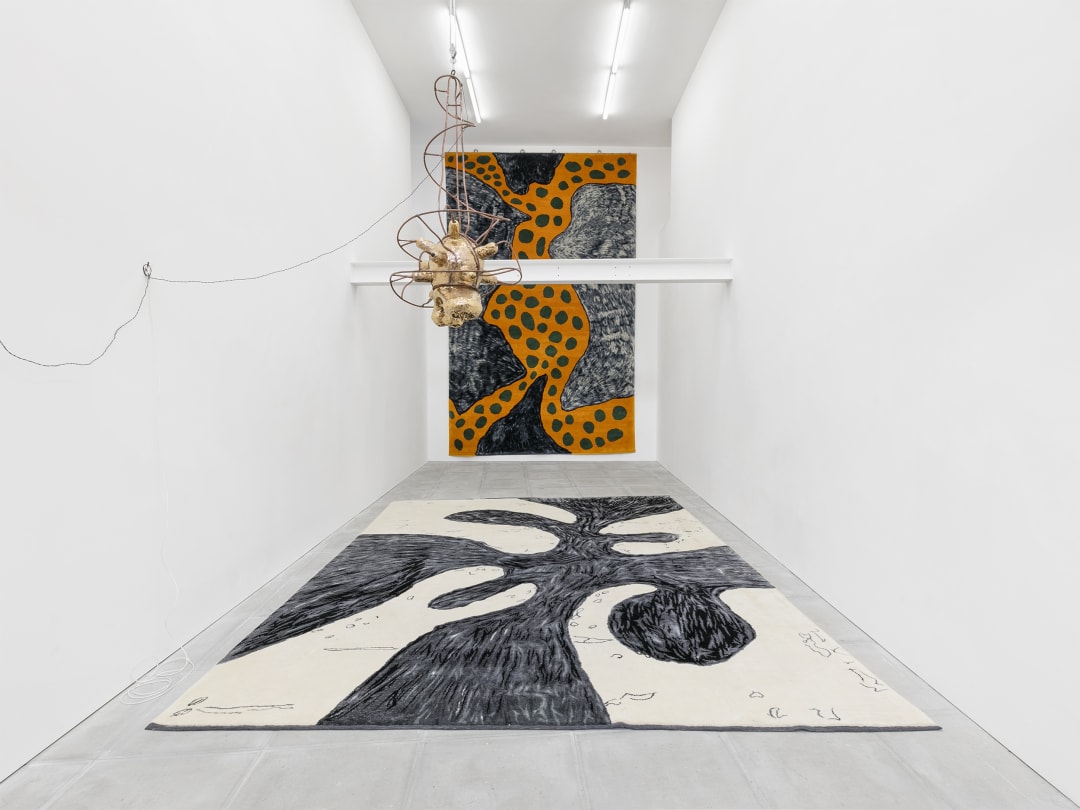We are pleased to announce the opening of Take Off, Nicholas Pope’s second solo exhibition at the gallery.
Take Off coincides with two other major exhibitions of Pope's work: Portraits of a Marriage at the Holburne Museum, Bath and Heavenly Space at the New Art Centre, Salisbury.
Alongside Pope's series of 'helmet' sculptures and drawings from the 80's and 90's this exhibition focuses on a recently completed body of work and its engagement with a new medium, a soft furnishing of sorts, typical to the artist's work, in which older drawings have been revisited and transmitted into a different medium. This new medium is deep pile carpet which lends itself to the wobbly colourful drawings that are always the starting point for anything that Pope creates.
Pope has had a longstanding fascination with a strange domestic purgatory, previously even devising a plan for turning a road service station into a kind of cathedral of art and contemplation. Deep pile carpet, Judeo Christian theology, service stations; they all seem to speak something of a type of 'Englishness' that exists outside of time.
The simplicity of moving in a direction and having only that route to consider seems an apt metaphor for the day to day work that Pope has found himself in from 1982 to the present day, following a visit to Tanzania where Pope was struck down by encephalitis and then Parkinson’s. A cerebral shattering fragmentation of reality, followed by a cognitive reshuffling, Pope could only go in one direction, could only make in one way. Creation as self-excavation helped Pope come to terms with his new reality.
To quote Einstein, ‘the distinction between the past, present and future is only a stubbornly persistent illusion’. We should consider that a truer representation of what we experience to be more like white noise with all the moments sitting jumbled together in the same plain and not the reassuring chronology we are so fortunate to be presented by our own brains in order to keep us ‘sane’.
There might be three and a half decades between the creation of a drawing and its transmutation into deep pile rug but there’s also no time at all. Speaking of the cerebral, you walked past a few strange objects on your way in. His rarely seen helmet works are the first to greet you and perhaps these hold the key, the Rosetta stone of Pope. You might be able to persuade the tired looking person who greeted you downstairs from their windowless office, to allow you to poke your head inside one of these works (in the pursuit of artistic understanding of course).
Drawing, sculpture, hard materials, soft materials, transmutations, journeys, time, the reason Pope was in Tanzania and therefore contracted his illness was his deep respect for the Makonde Carvers. A Makonde myth says that the mother of all the Makonde was originally a wooden carving that came to life, a sort of morphing from dreams to reality via abstract form, things seeming to come full circle. Either way we are left feeling strangely resolved amongst the recognised and unrecognisable forms and poorly remembered biblical references peppered throughout the exhibition.
Nicholas Pope (b.1949) Lives and Works in Ledbury and London, UK. Selected exhibitions include Portraits of a Marriage, Holburne Museum,, Bath, 2021; With us in Nature, Kröller-Müller Museum, Netherlands 2019; Sins & Virtues, The Sunday Painter, London, 2018 Sticky Intimacy, Chapter, Cardiff, UK, 2016; Baldock Pope Zahle, Northern Gallery for Contemporary Art, Sunderland, UK , 2016, Nicholas Pope: The Apostles Speaking in Tongues, (In collaboration with New Art Centre) Salisbury Cathedral, Salisbury, UK, 2014, Richard Saltoun Gallery, London, 2014, New Art Centre, Roche Court Sculpture Park, Salisbury, UK, 2013, The Ten Commandments in Flowing Light, Art & Project, Slootdorp, The Netherlands, 2001, Art Now: Nicholas Pope: The Apostles Speaking in Tongues, Tate Gallery, London, UK, 1996, Art & Project, Amsterdam, The Netherlands, 1992; Waddington Galleries, London, UK, 1986; Nicholas Pope: Wax Drawings and Sculpture, John Hansard Gallery, University of Southampton, Southampton, UK, 1982; Rijksmuseum Kröller-Müller, Otterlo, The Netherlands, 1981; British Pavilion, Venice Biennale, Venice, Italy, 1980; Summer Show 3, Serpentine Gallery, London, UK, 1976; Arts Council Collection, Hayward Gallery, London, UK, 1976; The Condition of Sculpture, Hayward Gallery, London, UK, 1975.

